Economics for Business: Australia Post Monopoly and Government Role
VerifiedAdded on 2023/04/21
|5
|1293
|288
Essay
AI Summary
This essay examines the monopoly market structure in Australia, focusing on Australia Post as a case study. It identifies inefficiencies arising from Australia Post's monopoly power, such as potential deadweight loss and reduced innovation. The analysis explores how government intervention, through bodies like the ACCC, aims to curb this power and promote a more efficient outcome for the economy by regulating prices, preventing market dominance, and addressing disputes. The essay also highlights the unique characteristics of a monopoly, including barriers to entry and the absence of close substitutes, which contribute to Australia Post's position as a price maker in the postal service market.
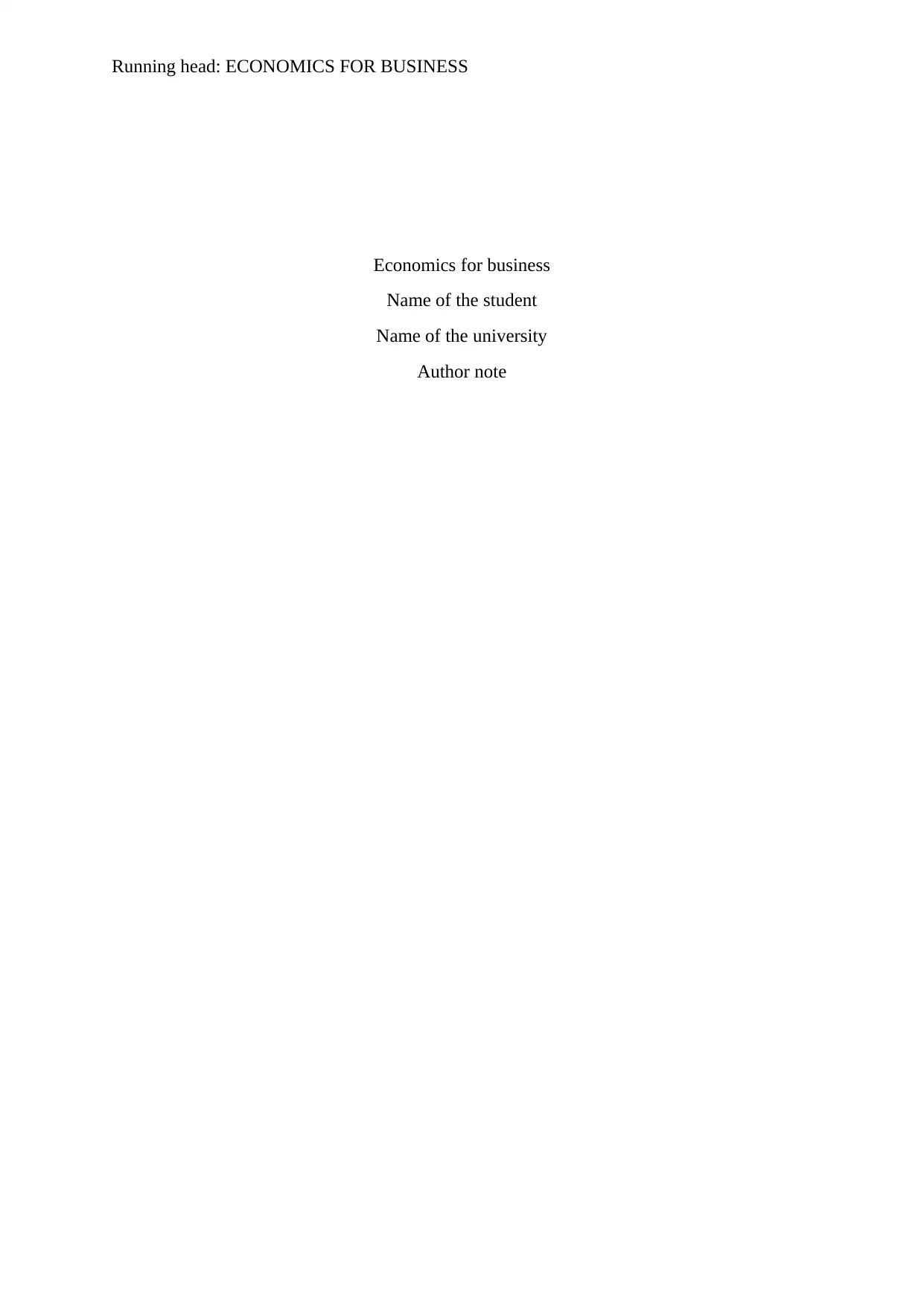
Running head: ECONOMICS FOR BUSINESS
Economics for business
Name of the student
Name of the university
Author note
Economics for business
Name of the student
Name of the university
Author note
Paraphrase This Document
Need a fresh take? Get an instant paraphrase of this document with our AI Paraphraser
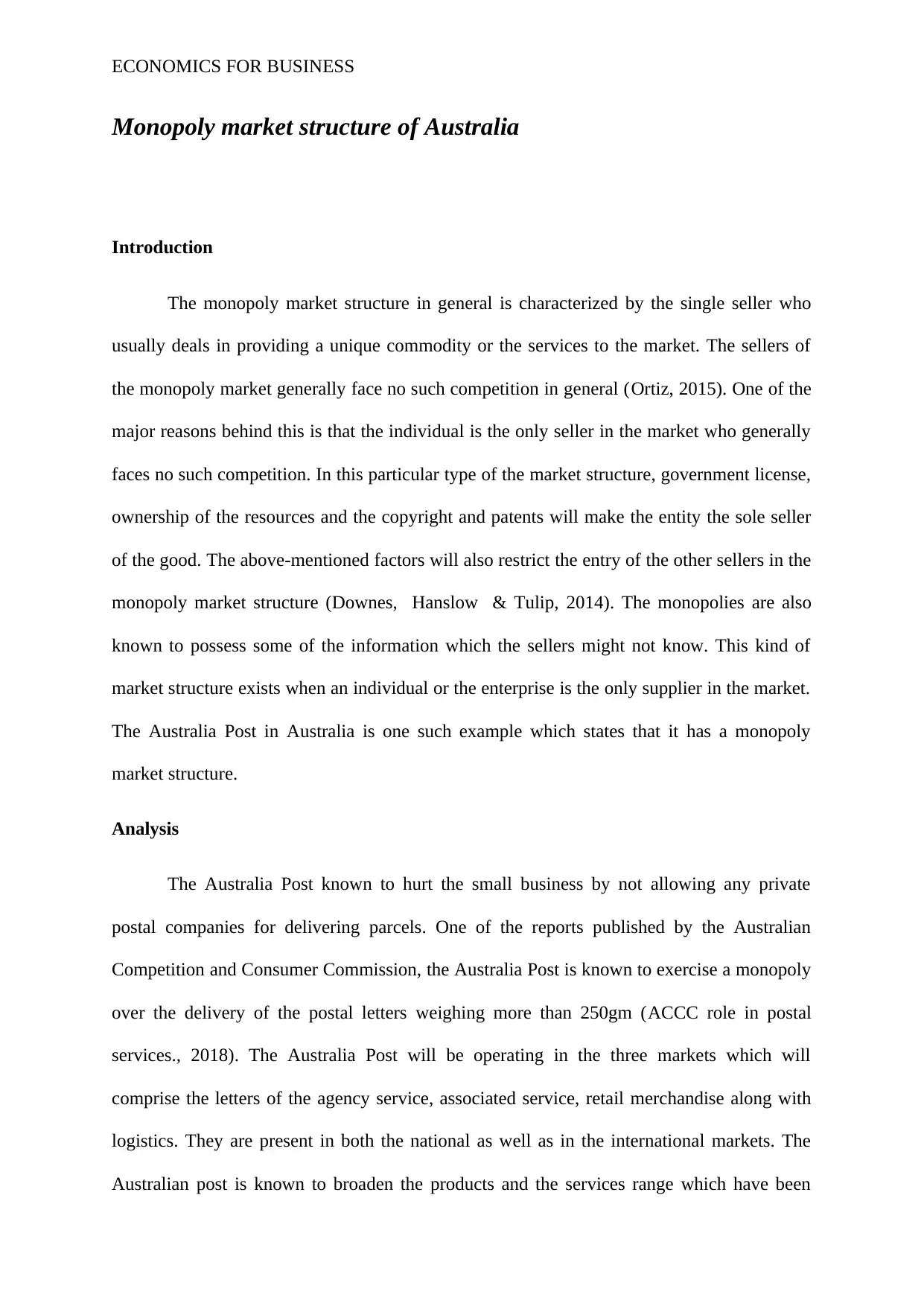
ECONOMICS FOR BUSINESS
Monopoly market structure of Australia
Introduction
The monopoly market structure in general is characterized by the single seller who
usually deals in providing a unique commodity or the services to the market. The sellers of
the monopoly market generally face no such competition in general (Ortiz, 2015). One of the
major reasons behind this is that the individual is the only seller in the market who generally
faces no such competition. In this particular type of the market structure, government license,
ownership of the resources and the copyright and patents will make the entity the sole seller
of the good. The above-mentioned factors will also restrict the entry of the other sellers in the
monopoly market structure (Downes, Hanslow & Tulip, 2014). The monopolies are also
known to possess some of the information which the sellers might not know. This kind of
market structure exists when an individual or the enterprise is the only supplier in the market.
The Australia Post in Australia is one such example which states that it has a monopoly
market structure.
Analysis
The Australia Post known to hurt the small business by not allowing any private
postal companies for delivering parcels. One of the reports published by the Australian
Competition and Consumer Commission, the Australia Post is known to exercise a monopoly
over the delivery of the postal letters weighing more than 250gm (ACCC role in postal
services., 2018). The Australia Post will be operating in the three markets which will
comprise the letters of the agency service, associated service, retail merchandise along with
logistics. They are present in both the national as well as in the international markets. The
Australian post is known to broaden the products and the services range which have been
Monopoly market structure of Australia
Introduction
The monopoly market structure in general is characterized by the single seller who
usually deals in providing a unique commodity or the services to the market. The sellers of
the monopoly market generally face no such competition in general (Ortiz, 2015). One of the
major reasons behind this is that the individual is the only seller in the market who generally
faces no such competition. In this particular type of the market structure, government license,
ownership of the resources and the copyright and patents will make the entity the sole seller
of the good. The above-mentioned factors will also restrict the entry of the other sellers in the
monopoly market structure (Downes, Hanslow & Tulip, 2014). The monopolies are also
known to possess some of the information which the sellers might not know. This kind of
market structure exists when an individual or the enterprise is the only supplier in the market.
The Australia Post in Australia is one such example which states that it has a monopoly
market structure.
Analysis
The Australia Post known to hurt the small business by not allowing any private
postal companies for delivering parcels. One of the reports published by the Australian
Competition and Consumer Commission, the Australia Post is known to exercise a monopoly
over the delivery of the postal letters weighing more than 250gm (ACCC role in postal
services., 2018). The Australia Post will be operating in the three markets which will
comprise the letters of the agency service, associated service, retail merchandise along with
logistics. They are present in both the national as well as in the international markets. The
Australian post is known to broaden the products and the services range which have been
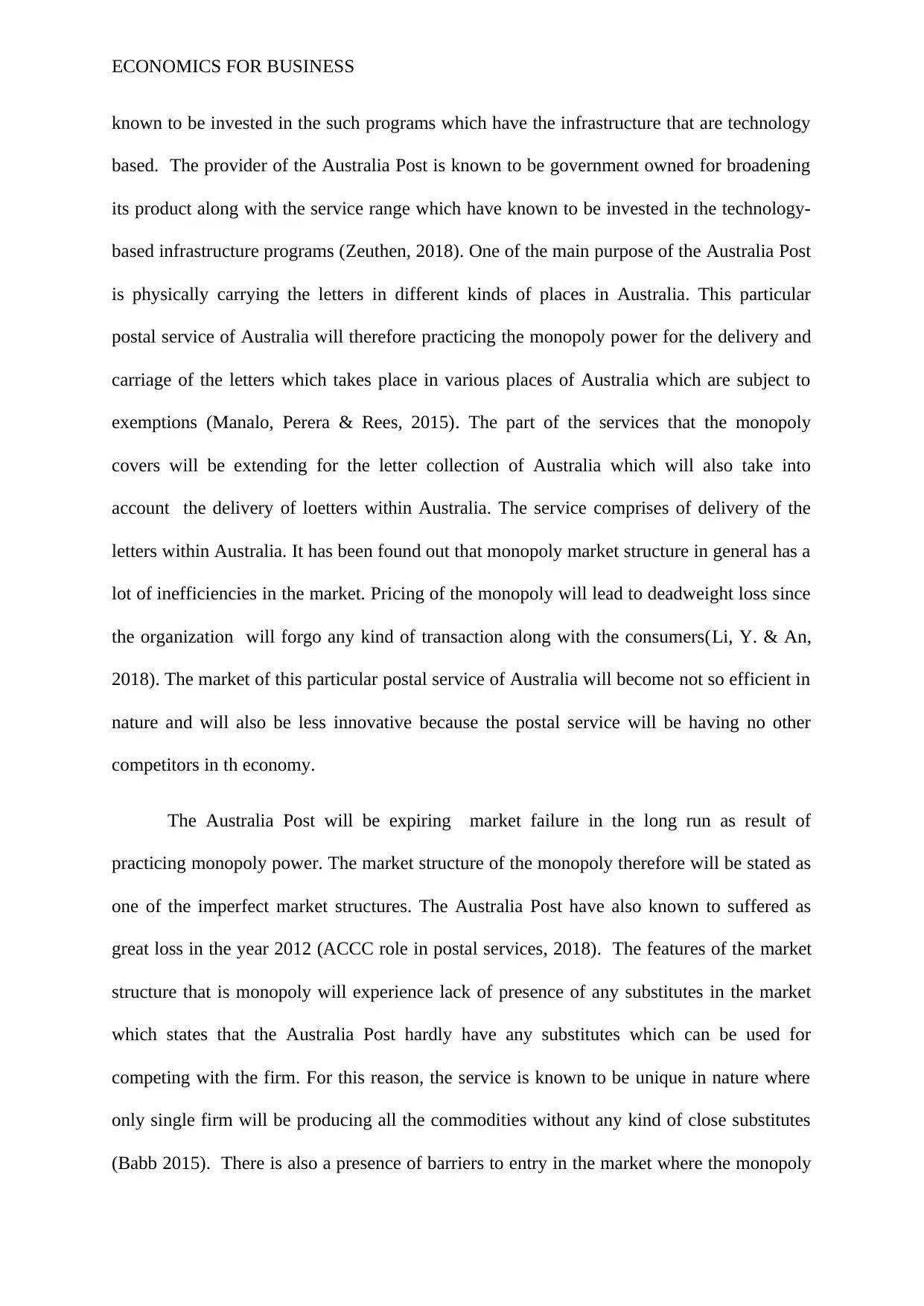
ECONOMICS FOR BUSINESS
known to be invested in the such programs which have the infrastructure that are technology
based. The provider of the Australia Post is known to be government owned for broadening
its product along with the service range which have known to be invested in the technology-
based infrastructure programs (Zeuthen, 2018). One of the main purpose of the Australia Post
is physically carrying the letters in different kinds of places in Australia. This particular
postal service of Australia will therefore practicing the monopoly power for the delivery and
carriage of the letters which takes place in various places of Australia which are subject to
exemptions (Manalo, Perera & Rees, 2015). The part of the services that the monopoly
covers will be extending for the letter collection of Australia which will also take into
account the delivery of loetters within Australia. The service comprises of delivery of the
letters within Australia. It has been found out that monopoly market structure in general has a
lot of inefficiencies in the market. Pricing of the monopoly will lead to deadweight loss since
the organization will forgo any kind of transaction along with the consumers(Li, Y. & An,
2018). The market of this particular postal service of Australia will become not so efficient in
nature and will also be less innovative because the postal service will be having no other
competitors in th economy.
The Australia Post will be expiring market failure in the long run as result of
practicing monopoly power. The market structure of the monopoly therefore will be stated as
one of the imperfect market structures. The Australia Post have also known to suffered as
great loss in the year 2012 (ACCC role in postal services, 2018). The features of the market
structure that is monopoly will experience lack of presence of any substitutes in the market
which states that the Australia Post hardly have any substitutes which can be used for
competing with the firm. For this reason, the service is known to be unique in nature where
only single firm will be producing all the commodities without any kind of close substitutes
(Babb 2015). There is also a presence of barriers to entry in the market where the monopoly
known to be invested in the such programs which have the infrastructure that are technology
based. The provider of the Australia Post is known to be government owned for broadening
its product along with the service range which have known to be invested in the technology-
based infrastructure programs (Zeuthen, 2018). One of the main purpose of the Australia Post
is physically carrying the letters in different kinds of places in Australia. This particular
postal service of Australia will therefore practicing the monopoly power for the delivery and
carriage of the letters which takes place in various places of Australia which are subject to
exemptions (Manalo, Perera & Rees, 2015). The part of the services that the monopoly
covers will be extending for the letter collection of Australia which will also take into
account the delivery of loetters within Australia. The service comprises of delivery of the
letters within Australia. It has been found out that monopoly market structure in general has a
lot of inefficiencies in the market. Pricing of the monopoly will lead to deadweight loss since
the organization will forgo any kind of transaction along with the consumers(Li, Y. & An,
2018). The market of this particular postal service of Australia will become not so efficient in
nature and will also be less innovative because the postal service will be having no other
competitors in th economy.
The Australia Post will be expiring market failure in the long run as result of
practicing monopoly power. The market structure of the monopoly therefore will be stated as
one of the imperfect market structures. The Australia Post have also known to suffered as
great loss in the year 2012 (ACCC role in postal services, 2018). The features of the market
structure that is monopoly will experience lack of presence of any substitutes in the market
which states that the Australia Post hardly have any substitutes which can be used for
competing with the firm. For this reason, the service is known to be unique in nature where
only single firm will be producing all the commodities without any kind of close substitutes
(Babb 2015). There is also a presence of barriers to entry in the market where the monopoly
⊘ This is a preview!⊘
Do you want full access?
Subscribe today to unlock all pages.

Trusted by 1+ million students worldwide
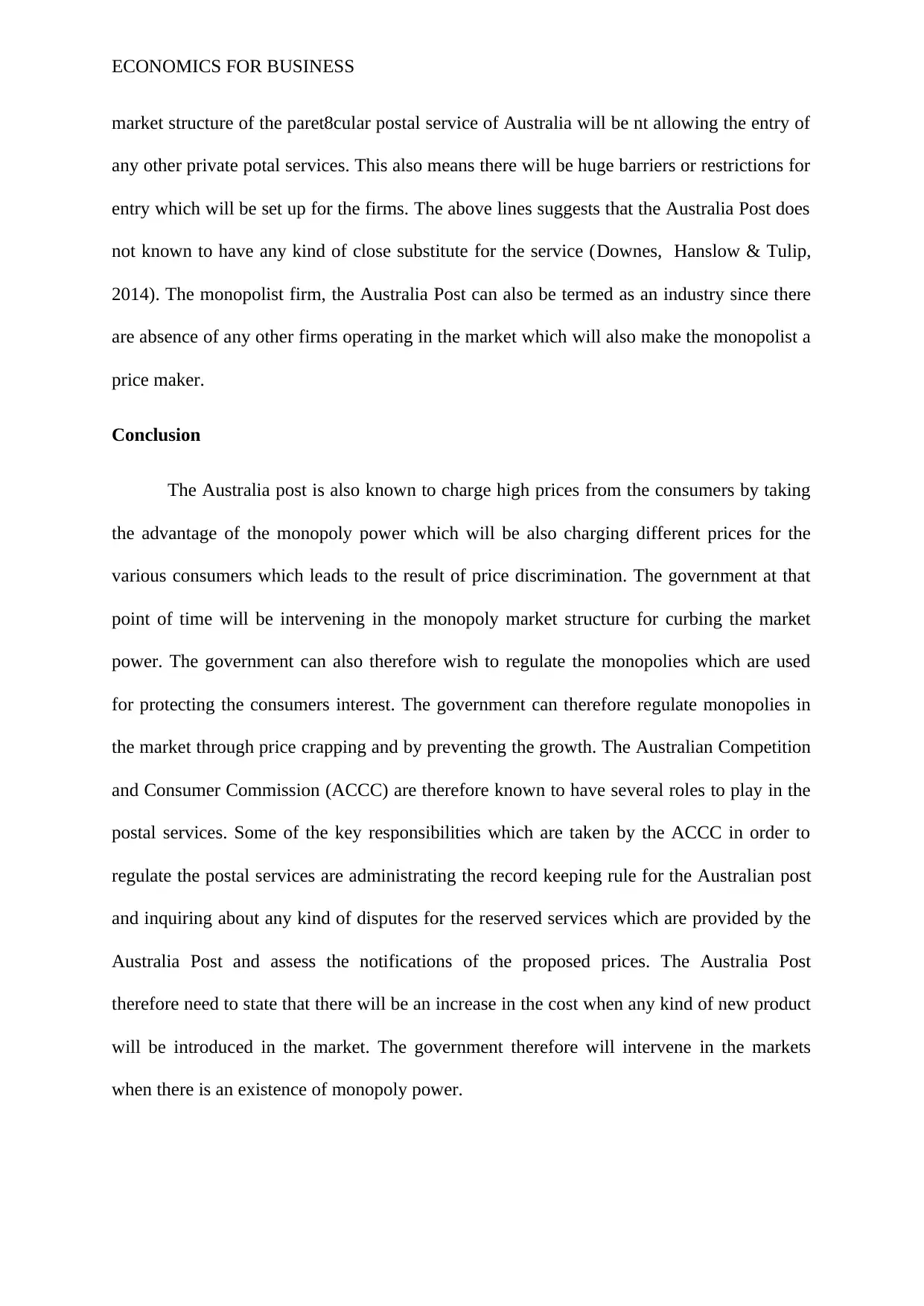
ECONOMICS FOR BUSINESS
market structure of the paret8cular postal service of Australia will be nt allowing the entry of
any other private potal services. This also means there will be huge barriers or restrictions for
entry which will be set up for the firms. The above lines suggests that the Australia Post does
not known to have any kind of close substitute for the service (Downes, Hanslow & Tulip,
2014). The monopolist firm, the Australia Post can also be termed as an industry since there
are absence of any other firms operating in the market which will also make the monopolist a
price maker.
Conclusion
The Australia post is also known to charge high prices from the consumers by taking
the advantage of the monopoly power which will be also charging different prices for the
various consumers which leads to the result of price discrimination. The government at that
point of time will be intervening in the monopoly market structure for curbing the market
power. The government can also therefore wish to regulate the monopolies which are used
for protecting the consumers interest. The government can therefore regulate monopolies in
the market through price crapping and by preventing the growth. The Australian Competition
and Consumer Commission (ACCC) are therefore known to have several roles to play in the
postal services. Some of the key responsibilities which are taken by the ACCC in order to
regulate the postal services are administrating the record keeping rule for the Australian post
and inquiring about any kind of disputes for the reserved services which are provided by the
Australia Post and assess the notifications of the proposed prices. The Australia Post
therefore need to state that there will be an increase in the cost when any kind of new product
will be introduced in the market. The government therefore will intervene in the markets
when there is an existence of monopoly power.
market structure of the paret8cular postal service of Australia will be nt allowing the entry of
any other private potal services. This also means there will be huge barriers or restrictions for
entry which will be set up for the firms. The above lines suggests that the Australia Post does
not known to have any kind of close substitute for the service (Downes, Hanslow & Tulip,
2014). The monopolist firm, the Australia Post can also be termed as an industry since there
are absence of any other firms operating in the market which will also make the monopolist a
price maker.
Conclusion
The Australia post is also known to charge high prices from the consumers by taking
the advantage of the monopoly power which will be also charging different prices for the
various consumers which leads to the result of price discrimination. The government at that
point of time will be intervening in the monopoly market structure for curbing the market
power. The government can also therefore wish to regulate the monopolies which are used
for protecting the consumers interest. The government can therefore regulate monopolies in
the market through price crapping and by preventing the growth. The Australian Competition
and Consumer Commission (ACCC) are therefore known to have several roles to play in the
postal services. Some of the key responsibilities which are taken by the ACCC in order to
regulate the postal services are administrating the record keeping rule for the Australian post
and inquiring about any kind of disputes for the reserved services which are provided by the
Australia Post and assess the notifications of the proposed prices. The Australia Post
therefore need to state that there will be an increase in the cost when any kind of new product
will be introduced in the market. The government therefore will intervene in the markets
when there is an existence of monopoly power.
Paraphrase This Document
Need a fresh take? Get an instant paraphrase of this document with our AI Paraphraser
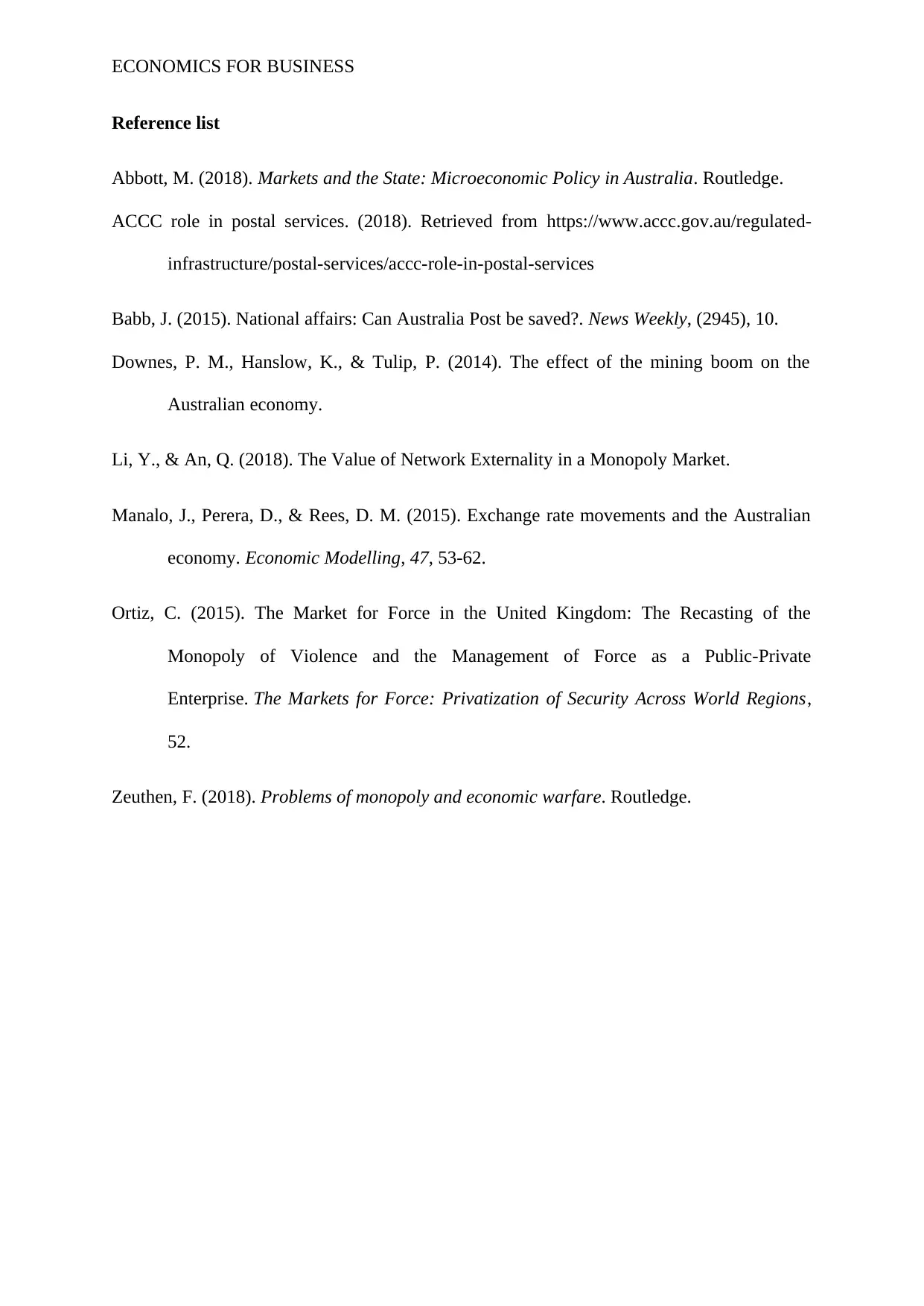
ECONOMICS FOR BUSINESS
Reference list
Abbott, M. (2018). Markets and the State: Microeconomic Policy in Australia. Routledge.
ACCC role in postal services. (2018). Retrieved from https://www.accc.gov.au/regulated-
infrastructure/postal-services/accc-role-in-postal-services
Babb, J. (2015). National affairs: Can Australia Post be saved?. News Weekly, (2945), 10.
Downes, P. M., Hanslow, K., & Tulip, P. (2014). The effect of the mining boom on the
Australian economy.
Li, Y., & An, Q. (2018). The Value of Network Externality in a Monopoly Market.
Manalo, J., Perera, D., & Rees, D. M. (2015). Exchange rate movements and the Australian
economy. Economic Modelling, 47, 53-62.
Ortiz, C. (2015). The Market for Force in the United Kingdom: The Recasting of the
Monopoly of Violence and the Management of Force as a Public-Private
Enterprise. The Markets for Force: Privatization of Security Across World Regions,
52.
Zeuthen, F. (2018). Problems of monopoly and economic warfare. Routledge.
Reference list
Abbott, M. (2018). Markets and the State: Microeconomic Policy in Australia. Routledge.
ACCC role in postal services. (2018). Retrieved from https://www.accc.gov.au/regulated-
infrastructure/postal-services/accc-role-in-postal-services
Babb, J. (2015). National affairs: Can Australia Post be saved?. News Weekly, (2945), 10.
Downes, P. M., Hanslow, K., & Tulip, P. (2014). The effect of the mining boom on the
Australian economy.
Li, Y., & An, Q. (2018). The Value of Network Externality in a Monopoly Market.
Manalo, J., Perera, D., & Rees, D. M. (2015). Exchange rate movements and the Australian
economy. Economic Modelling, 47, 53-62.
Ortiz, C. (2015). The Market for Force in the United Kingdom: The Recasting of the
Monopoly of Violence and the Management of Force as a Public-Private
Enterprise. The Markets for Force: Privatization of Security Across World Regions,
52.
Zeuthen, F. (2018). Problems of monopoly and economic warfare. Routledge.
1 out of 5
Related Documents
Your All-in-One AI-Powered Toolkit for Academic Success.
+13062052269
info@desklib.com
Available 24*7 on WhatsApp / Email
![[object Object]](/_next/static/media/star-bottom.7253800d.svg)
Unlock your academic potential
Copyright © 2020–2025 A2Z Services. All Rights Reserved. Developed and managed by ZUCOL.





